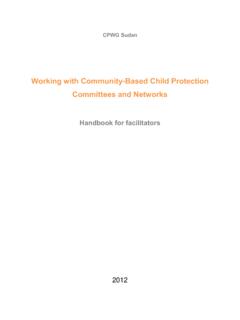Transcription of WHY SHOULD GOVERNMENT SUPPORT THE ARTS?
1 S T A T E P O L I C Y B R I E F S Tools for Arts Decision Making WHY SHOULD GOVERNMENT SUPPORT THE ARTS? Federal, state and local lawmakers have difficult jobs. They are expected to resolve some of the most wicked problems of our time: How can America ensure long-term economic growth? How can we solve chronic problems with education and health care? What public policies will strengthen America's global position? And what roles and responsibilities must our GOVERNMENT assume or shed in order to best serve citizens? In this environment, all areas of spending including the arts come under scrutiny, and every public dollar is competitive. Lawmakers may ask whether GOVERNMENT has a legitimate role to play in the arts, or whether the arts SHOULD receive funds when so many other critical needs are pressing. The answer to both questions is a resounding, evidence based "Yes." This Policy Brief helps lawmakers, civic leaders, businesspeople, educators and cultural advocates answer common questions about GOVERNMENT arts funding.
2 For more information, explore the Research and Advocacy sections of the National Assembly of State Arts agencies (NASAA) website or contact the NASAA office at 202-347-6352. Contents 1. Why are the arts a good public-sector investment? .. 2 2. Does every state fund the arts? .. 3 3. What do states currently invest in the arts? .. 4 4. How do federal arts funds impact states? .. 4 5. Can't we just use federal funds without any state funds? .. 5 6. Why can't local GOVERNMENT take on the responsibility? .. 6 7. Why can't the private sector do this job by itself? .. 6 8. Shouldn't the arts just be supported by those who attend? .. 7 9. Aren't there more serious issues GOVERNMENT SHOULD address? .. 7 10. Don't arts funds mostly benefit big cities?.. 8 11. Aren't the arts a pastime of the elite? .. 9 12. Why SUPPORT the arts in hard times?..10 13. Will cutting the arts help balance GOVERNMENT budgets?
3 10 14. Does GOVERNMENT arts funding cause dependence on public dollars? .. 10 15. Is SUPPORT for the arts a partisan issue? .. 11 16. Why are state arts agencies essential? .. 12 17. What the Research Says .. 13 Notes .. 21 1200 18th Street, NW Suite 1100 Washington, 20036 Tel: 202-347-6352 Fax: 202-737-0526 TDD: 202-296-0567 2017 by the National Assembly of State Arts agencies . You are free to copy, distribute and transmit this document or parts thereof for noncommercial purposes provided you use this copyright notice: This work is licensed under a Creative Commons Attribution-NonCommercial International License. W H Y S H O U L D G O V E R N M EN T S U P P O R T T H E A R T S ? 2 N A T I O N A L A S S E M B L Y O F S T A T E A R T S A G E N C I E S S t a t e P o l i c y B r i e f s 1. Why are the arts a good public-sector investment? (back to Contents) The arts are an important community builder and prosperity generator for states.
4 In addition to their inherent value to society, the arts offer a distinctive blend of benefits: ECONOMIC DRIVERS: The arts create jobs and produce tax revenue. A strong arts sector is an economic asset that stimulates business activity, attracts tourism and expands a state's work force and tax base. The arts have been shown to be a successful and sustainable strategy for revitalizing rural areas, cities and populations struggling with poverty. (Learn more.) EDUCATIONAL ASSETS: The arts cultivate young imaginations and facilitate success in school, enhancing students' academic achievement in multiple subject areas. They provide the critical-thinking, communications and innovation skills essential to a productive 21st-century work force. (Learn more.) HEALTH AND WELLNESS: The arts foster physical, mental and emotional health, aiding recovery processes and contributing to well-being. Arts therapy is a medically and economically effective tool for treating aging adults, children and people suffering from trauma, including military combat personnel and veterans.
5 (Learn more.) CIVIC CATALYSTS: The arts create a welcoming sense of place and a desirable quality of life. The arts also SUPPORT a strong democracy, engaging citizens in civic discourse, providing forums for important issues and encouraging collective problem solving. (Learn more.) CULTURAL LEGACIES: The arts preserve culture and heritage, passing along a state's unique character and traditions to future generations of citizens. (Learn more.) Lawmakers recognize other value-added advantages to making the arts a part of public policy: Incorporating the arts improves the impact of other state policies and services. Numerous states have incorporated the arts into economic revitalization, education, literacy, work-force development, tourism, community sustainability, social service and veterans-care plans. The arts are a dynamic contributor to the small-business sector. The creative industries are composed of many talented workers who are self-employed, freelancers or employed by microenterprises.
6 According to National Endowment for the Arts (NEA) analysis of Census occupational data, artists are nearly times more likely than the total work force to be self-employed ( vs. ).1 Many nonprofit arts organizations, too, are small businesses and play an important role in training creative workers and incubating artistic enterprises. "..governors and states are finding that arts, culture, and design can be important components of a comprehensive strategy for growth." National Governors Association W H Y S H O U L D G O V E R N M E N T S U P P O R T T H E A R T S ? N A T I O N A L A S S E M B L Y O F S T A T E A R T S A G E N C I E S 3 S t a t e P o l i c y B r i e f s The arts make communities vibrant, welcoming and desirable. Cultural places and events are magnetic, attracting not only artists but also families, travelers and businesses. Creative placemaking the gravitational effect of culture on neighborhoods positively impacts local economies and quality of life.
7 It creates jobs and stimulates commercial traffic, all of which leverage neighborhood revitalization, attract diverse populations and strengthen communities. Capitalizing on these effects of creative placemaking requires strong public-sector SUPPORT . The arts are a hallmark of state innovation. The arts are part of a state's creative capacity, spurring innovation and generating unique products and services. Creativity is part of any state's competitive edge in the global marketplace, where distinctive design and effective communications can spell the success or failure of a business or policy venture. Public funding of the arts is an investment with high yields. This starts from the top with federal funds: each $1 in federal arts funds leverages another $9 from other public and private sources, resulting in $500 million in matching Leading public-sector organizations including the National Governors Association, the National Conference of State Legislatures, the Conference of Mayors and the Education Commission of the States have indentified the arts as part of a strong state policy portfolio.
8 Business leaders, economists, property developers, tourism officials and community planners have joined with parents, educators and civic leaders to promote public policies that strengthen the arts. They do so because they recognize the benefits that accrue to communities when GOVERNMENT helps to foster a robust arts sector. And American taxpayers concur. Indeed, 57% of them approve of state GOVERNMENT providing funding to artists and arts organizations, while 58% SUPPORT such investments from local GOVERNMENT . Among "likely voters," this approval increases to 60% for state arts funding and 62% for local arts funding. Furthermore, a strong majority of Americans 55% favor increasing federal investment in the 2. Does every state fund the arts? (back to Contents) Yes. Like most areas of public spending, state appropriations to the arts have seen periods of growth and decline tied to state budget conditions.
9 State governments have maintained a commitment to the arts by allocating funding even during recessions to state arts agencies and their programs. "Arts and culture are consistent sources of economic growth, during both good and difficult economic times. Specifically, arts and culture policies and programs increase economic development in states by attracting businesses, creating new jobs, increasing tax revenues and promoting tourism." National Conference of State Legislatures W H Y S H O U L D G O V E R N M EN T S U P P O R T T H E A R T S ? 4 N A T I O N A L A S S E M B L Y O F S T A T E A R T S A G E N C I E S S t a t e P o l i c y B r i e f s 3. What do states currently invest in the arts? (back to Contents) Legislative appropriations to all state and jurisdictional arts agencies in fiscal year 2017 totaled $368 million, or $ per This represents only less than one-half of one-tenth of one percent of state general fund Yet the return on this investment is tremendous.
10 State arts agencies SUPPORT more than 21,600 projects undertaken by communities, organizations, schools, individual artists and others, making the economic, educational, civic and cultural benefits of the arts available across the United Over time, changes to legislative appropriations to the arts mirror the health of overall state budgets. State arts agencies operate with no reserves, dedicating all available resources to current constituent services. This means that even small-magnitude cuts to state arts funding tend to have a high-magnitude impact, resulting in fewer communities reached, numerous projects cancelled, loss of leveraged funds and gaps in services to the public. 4. How do federal arts funds impact states? (back to Contents) In addition to awarding direct grants to every state and congressional district in the country more than 2,400 grants benefiting more than 16,000 communities in 2016 the National Endowment for the Arts, by law, dedicates 40% of its grant-making funds ($47 million in 2017) to state and regional arts This state-federal partnership has several important merits: NEA partnership funds SUPPORT state priorities.



